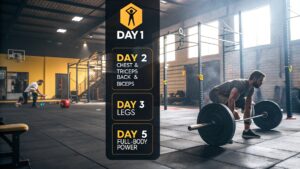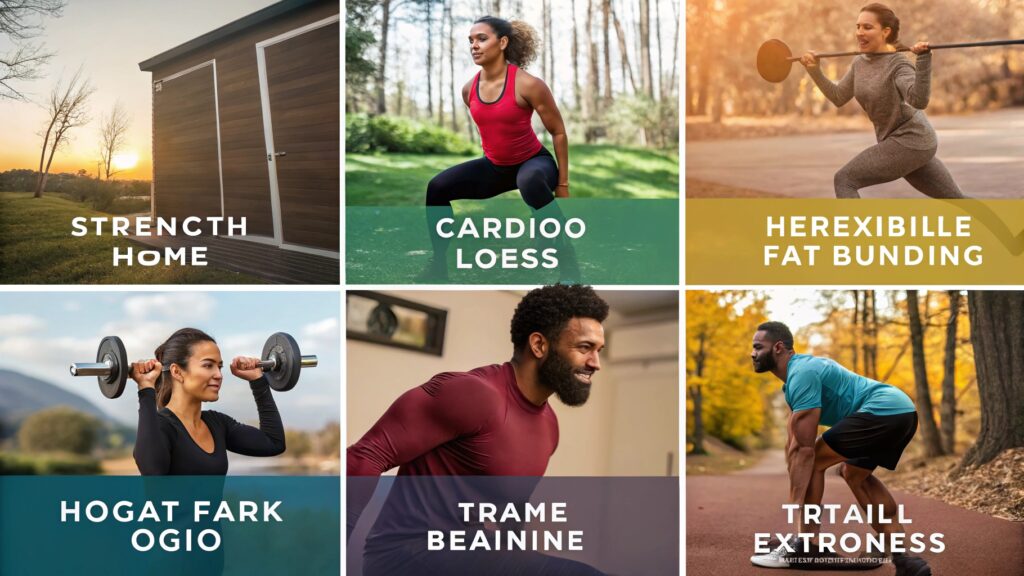Introduction
7 Workout Plans to Try Based on Your Fitness Goal– Finding the right training program can feel like searching for a needle in a haystack, especially when the fitness industry throws countless buzzwords at you each week. Whether you’re aiming to shed stubborn pounds, pack on lean muscle, boost endurance for a marathon, or simply improve overall health, the key is matching the workout to your specific goal. In this guide we’ll explore 7 workout plans to try based on your fitness goal, each backed by scientific research and real‑world results. By the end you’ll know exactly which regimen aligns with your objectives, how to structure it, and what tools can accelerate your progress.
Why Goal‑Based Programming Works –
Goal‑oriented programming is grounded in the principle of specificity—the idea that the body adapts precisely to the stresses placed upon it. A 2022 meta‑analysis published in the Journal of Sports Sciences found that participants who followed a clearly defined training goal (e.g., fat loss, hypertrophy) achieved 12‑15 % greater improvements than those who trained “general fitness” without a target. This happens because the nervous system, hormonal environment, and recovery protocols can all be fine‑tuned when you know the desired outcome. For beginners, a clear goal eliminates guesswork, keeps motivation high, and makes progress tracking straightforward.
How to Choose Your Plan – Paragraph 2
Start by answering three simple questions: (1) What measurable outcome matters most to you—weight, strength, speed, or flexibility? (2) How many days per week can you realistically commit? (3) Do you prefer equipment‑heavy gym sessions, bodyweight at home, or a hybrid approach? Once you have those answers, cross‑reference them with the seven proven workout structures outlined below. Each plan includes recommended weekly splits, example exercises, and evidence‑based tips to optimize results while minimizing injury risk. Remember, consistency beats perfection, so pick the plan you can sustain for at least 8‑12 weeks before deciding whether to tweak or switch.
Fat‑Loss Focus: High‑Intensity Interval Training (HIIT)
What Makes HIIT Ideal for Weight Loss – Paragraph 1
HIIT alternates short bursts of maximal effort (30‑90 seconds) with brief recovery periods, creating a metabolic “afterburn” known as excess post‑exercise oxygen consumption (EPOC). A 2021 systematic review in Obesity Reviews reported that HIIT can burn up to 30 % more calories post‑workout than traditional steady‑state cardio, despite requiring half the time. This efficiency makes HIIT perfect for busy professionals who want to shed body fat without spending hours on the treadmill.
Sample 4‑Day HIIT Schedule – Paragraph 2
-
- Monday – Full‑Body Sprint Circuit: 5 × 30 s bike sprint, 30 s rest; 4 × 20 s kettlebell swings, 40 s rest.
-
- Wednesday – Plyo & Core: 4 × 45 s box jumps, 15 s rest; 3 × 30 s plank variations, 30 s rest.
-
- Friday – Upper‑Body Blast: 5 × 20 s battle‑rope waves, 40 s rest; 4 × 25 s push‑up bursts, 35 s rest.
-
- Saturday – Active Recovery: Light yoga or brisk 20‑minute walk.
Actionable Tips & Safety – Keep heart‑rate zones in mind: aim for 85‑95 % of max during work intervals. Warm up for 5 minutes with dynamic stretches, and cool down with static stretching to protect joints. Beginners should start with 12‑minute sessions and gradually add 2‑minute increments each week.
Muscle‑Building Blueprint: Classic Bodybuilding Split

Why a Split Routine Drives Hypertrophy – Paragraph 1
Traditional bodybuilding splits isolate muscle groups, allowing for higher volume (sets × reps) per session—a critical factor for muscle protein synthesis. Research from the American College of Sports Medicine indicates that 10‑12 sets per muscle per week maximize hypertrophic response, provided loads are ≥ 70 % of 1RM (one‑rep max). By dedicating a day to each major group, you can concentrate on progressive overload without compromising form.
Example 5‑Day Split – Paragraph 2
-
- Day 1 – Chest & Triceps: Bench press 4 × 8, Incline dumbbell press 3 × 10, Dips 3 × 12, Overhead tricep extension 3 × 10.
-
- Day 2 – Back & Biceps: Pull‑ups 4 × 6, Barbell row 4 × 8, Lat pulldown 3 × 10, EZ‑bar curls 3 × 12.
-
- Day 3 – Legs: Squats 5 × 6, Romanian deadlift 4 × 8, Leg press 3 × 10, Calf raises 4 × 15.
-
- Day 4 – Shoulders & Abs: Military press 4 × 8, Lateral raises 3 × 12, Face pulls 3 × 15, Hanging leg raise 3 × 15.
-
- Day 5 – Full‑Body Power: Clean & press 4 × 5, Weighted lunges 3 × 8 each leg, Farmer’s walk 3 × 30 seconds.
Expert Insight & Nutrition – Dr. Brad Schoenfeld, PhD, emphasizes pairing this split with 1.6‑2.2 g protein/kg body weight daily and a modest caloric surplus of 250‑500 kcal. Track progress with a training log; aim to increase weight or reps each week (the “progressive overload” principle) while maintaining proper technique.
Endurance Engine: Periodized Running Program
Periodization Explained – Paragraph 1
Periodization breaks the training year into macro‑, meso‑, and micro‑cycles, each with a distinct focus (base, build, peak). This systematic variation prevents plateaus and overtraining—a common pitfall for marathon hopefuls. A 2020 longitudinal study in Medicine & Science in Sports & Exercise showed runners using a periodized plan improved VO₂ max by 6 % more than those who trained linearly.
Four‑Week Sample Cycle
-
- Week 1 (Base): 3 × 45‑minute easy runs at 60‑70 % max HR, plus one 30‑minute bike cross‑train.
-
- Week 2 (Build): Add a 6‑km tempo run at lactate threshold (80‑85 % HRmax).
-
- Week 3 (Peak): Include a 12‑km long run at steady pace, plus 4 × 800 m intervals (90 % HRmax) with equal rest.
-
- Week 4 (Recovery): Drop volume by 40 %, keep intensity low; include yoga or swimming for active recovery.
Practical Tools & Monitoring – Use a heart‑rate monitor or GPS watch with VO₂ max estimation to stay in prescribed zones. Hydration and electrolyte balance become crucial on long runs; a 16‑oz sports drink with 200‑300 mg sodium helps maintain performance. Incorporate a “run‑log” app (e.g., Strava, TrainingPeaks) to visualize mileage trends and spot early signs of fatigue.
Functional Fitness Fusion: CrossFit‑Style MetCon
Benefits of Metabolic Conditioning – Paragraph 1
MetCon (Metabolic Conditioning) blends strength, cardio, and gymnastics in high‑intensity circuits, improving all‑round athleticism. The National Strength and Conditioning Association (NSCA) reports that MetCon can elevate anaerobic capacity by 15‑20 % while simultaneously increasing maximal strength. This dual stimulus makes it ideal for individuals seeking functional strength for daily activities or sports.
Typical “Fran”‑Inspired WOD – Paragraph 2
-
- 21‑15‑9: Thrusters (45 lb/30 lb) + Pull‑ups.
-
- Time cap: 7 minutes.
-
- Scaling: Use a kettlebell swing instead of thruster and band‑assisted pull‑ups for beginners.
Comparisons & Challenges – Paragraph 3
Compared with traditional bodybuilding, MetCon offers superior cardiovascular benefits but may yield slower linear strength gains due to higher fatigue. The primary challenge is mastering technique under fatigue; therefore, schedule a dedicated skill day once a week (e.g., double‑unders, hand‑stand progressions). Also, monitor for signs of overreaching—persistent soreness beyond 72 hours, elevated resting heart rate, or decreased sleep quality—since MetCon’s high volume can tax recovery systems quickly.
Flexibility & Mobility Blueprint: Yoga‑Pilates Hybrid
Why Mobility Matters – Paragraph 1
Adequate flexibility reduces injury risk and enhances movement efficiency. A 2018 study in The Clinical Journal of Sports Medicine demonstrated that participants who completed a 12‑week mobility program improved squat depth by 22 % and experienced 30 % fewer lower‑back complaints. Integrating yoga’s breath‑focused flow with Pilates’ core‑stability work creates a comprehensive mobility system.
Step‑by‑Step 3‑Day Routine
-
- Day 1 – Dynamic Flow (45 min): Sun Salutation A & B x3, Warrior II with pulses, standing hip openers, finish with a 5‑minute diaphragmatic breathing session.
-
- Day 2 – Core‑Pilates (40 min): Hundred, Roll‑Up, Single‑Leg Stretch, Side‑Kick Series, ending with a 2‑minute plank series (front, side, reverse).
-
- Day 3 – Restorative Stretch (30 min): Reclining pigeon, seated forward fold, supine twist, each held 3‑5 minutes, using props for support.
Tools & Progress Tracking – A yoga mat, foam roller, and resistance band are all you need. Use a mobility checklist to rate joint range of motion (ROM) on a 1‑10 scale every two weeks; aim for a 1‑2 point improvement per joint. Over time, you’ll notice smoother transitions in other workout plans—whether you’re dead‑lifting deeper or sprinting with better stride length.
Sports‑Specific Power: Olympic Lifting & Plyometrics
Science Behind Explosive Training – Paragraph 1
Olympic lifts (snatch, clean & jerk) and plyometric drills develop the phosphagen system, enabling rapid force production essential for athletes in basketball, football, or track & field. A 2019 ACSM position stand highlighted that athletes incorporating these modalities improve vertical jump height by an average of 5‑7 cm and sprint speed by 0.05‑0.08 seconds over 20 m.
Weekly Blueprint – Paragraph 2
-
- Monday – Technique & Strength: 5 × 2 snatch pulls @ 80 % 1RM, 4 × 3 clean & jerk @ 70 % 1RM, focusing on bar path.
-
- Wednesday – Plyo Circuit: Box jumps (3 × 10 × 30‑cm), depth jumps (3 × 8), medicine‑ball slams (3 × 12).
-
- Friday – Full Power Day: Power clean (4 × 3 @ 75 % 1RM) + weighted sled pushes (4 × 20 m)
Case Study & Implementation – Case: A collegiate sprinter added a 6‑week Olympic‑lifting block and shaved 0.06 seconds off his 100‑m personal best. Key success factors included: (1) a certified strength coach for technique, (2) 48‑hour recovery between heavy days, and (3) a concurrent mobility routine to maintain shoulder and hip health. For recreational athletes, start with a “technique‑only” phase (light loads, high reps) before progressing to heavier intensities.
Conclusion & Call‑to‑Action
Choosing the right workout plan is more than picking a trendy program—it’s about aligning training variables with your personal fitness goal, schedule, and injury history. The seven plans outlined above—HIIT for fat loss, classic bodybuilding split for muscle, periodized running for endurance, CrossFit‑style MetCon for functional strength, yoga‑pilates hybrid for mobility, and Olympic‑lifting power for sport—cover the full spectrum of objectives most people pursue.
Take the next step today: Identify which goal resonates most, select the corresponding plan, and commit to an 8‑week trial. Track your metrics (weight, reps, run pace, mobility scores) and adjust based on progress.
If you found this guide helpful, please share it on social media, leave a comment with your favorite plan, or read our related articles on nutrition strategies for each goal. Your experience could inspire someone else to finally find the perfect workout match!



